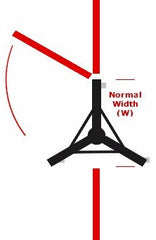
Description
Designed for:
Celestron C4-R, C5-S, C5-SGT, C6-N, C6-R, C6-RGT, C8, C8-NGT, C8-S, C8-SGT, C8+, C8-N, C8-S, C9ź-S, C9ź-SGT, C10-N, C10-NGT, C11-SGT, C102-HD, Celestar 8, CG-4 mount, CG-5 mount, CG-9ź, CGE 800** / 925** / 1100**, Classic 8, CPC 800 GPS / 925 GPS / 1100 GPS, Fastar 8, G-8, G8-N, G-9ź, Great Polaris C8, Great Polaris mount, NexStar 8 / 8 Evolution / 8 GPS / 8i / 8i (XLT) / 8 SE / 9ź Evolution / 9ź GPS / 11 GPS, Super C8 with adjustable tripod, Ultima 8 / 9ź / 11;
iOptron iEQ45 Pier mount;
Losmandy GM-8;
Meade 2080 and 2120 Fork mounts (except MTS) through LX200 7", 8" and 10" (Ritchey-Chrétien, GPS and non-GPS versions) with standard field tripod, LS-6 / 8, LT-6 / 8, LX90-ACF 8" / 10", LX90GPS 8" / 10", LX200-ACF 8" / 10", LX400-ACF 10", LXD55 AR-5 / AR-6 / SN-6 / SN-8 / SN-10, LXD75 AR-5 / AR-6 / SN-6 / SN-8 / SN-10, ETX-90EC and ETX-125EC with deluxe field tripod, LX10, LX50, LX90, LXD500 / 600 / 650 mounts, Starfinder German Equatorial 6 / 8 / 10;
Orion SkyView Pro mount;
Vixen Great Polaris mount, Great Polaris Deluxe mount
-
Maximum Load: 100 lbs
-
Adjusts to fit tripods with tip-to-tip distance from 32.5" to 43.5"
-
See doorway measurements for more dimensions.
-
Tip receptacle is 2-1/4" I.D.
-
Raises most mounts 3-1/2" off the ground with standard wheels (5" for Astro-Physics pier mounts)
-
Wheel diameter is 2-3/8" (optional 5" and 10" wheels are available)
You might also be interested in JMI’s "Speed Dial" drill adapter for quickly adjusting leveling screws on any Wheeley Bars.
** Your CGE mount may require Large Size Universal Wheeley Bars depending on the tip-to-tip distance. It may also require the 10" Pneumatic Large Wheel Upgrade (to lower the mount to an acceptable height).
NOTE: Do not use the standard Medium Wheeley Bars for 12" or larger SCTs (even if the mount is listed above) as these telescopes are too heavy for this product. Check out the HEAVY DUTY Version below.
|
|
The picture at left shows the Medium Size Universal Wheeley Bars with the standard 2-3/8" wheels. The optional 5" Large Wheels are also shown for size comparison. This picture shows the Medium Size Universal Wheeley Bars under a Meade Standard Field Tripod. The Wheeley Bars adjust for the legs of your tripod mount (within specific limits). They are designed to be used with the legs fully retracted to keep the center of gravity low and allow the telescope to be moved through doors |
Specifications
|
What are Wheeley Bars? Do you wish you had an easy way to move your tripod-mounted, pier-mounted or Dobsonian telescope from garage to patio or driveway? Wheeley Bars (telescope wheels/dolly) were created for just that purpose. The sturdy base with locking wheels and leveling bolts allows you to easily move, lock, level and use the complete telescope assembly. And best of all, you don't have to disconnect and reconnect all the electrical and computer cabling. Standard Wheeley Bars are designed to be used on hard flat surfaces only. With the optional large-wheel upgrade, great care in maneuvering and ideal conditions, they can be used on grass, dirt and gravel surfaces. Wheeley Bars are generally designed to be used with the tripod legs almost fully retracted to reduce the overall width. A Word of Warning: The heavier the telescope mounted on the Wheeley Bars, the more careful one must be in moving the complete system by pulling or pushing below the center of gravity. JMI is not responsible for incorrect loading or operation. |
|
What is Tip-to-Tip Distance? To be sure that your tripod or pier will fit a particular Wheeley Bar product, it may be necessary to verify the tip-to-tip distance of the mount. Usually, this measurement is made with the legs of a tripod fully retracted (the shortest length) and spread out completely. Alternately, you can measure at your preferred viewing height, but be sure to allow for the height of the Wheeley Bars (listed with each product). The tip-to-tip distance is the measurement from the outside edge of the end of a tripod leg or pier foot (where it touches the ground) to the outside edge of another tripod leg or pier foot as illustrated below.
Here are some examples of different types of tripods and piers and where to measure.
For Custom Wheeley Bars, to be sure that your mount will fit into the receptacles, we also need to know leg or foot diameter and tip style. For instance, on the mounts shown above (numbered from left to right), the following applies:
|
|
Doorway Measurements We often get questions regarding the width of our Wheeley Bars to determine if they will fit through a particular doorway. The following information should help in making that determination. The following dimensions do not apply to Wheeley Bars that have been upgraded with 10" large wheels. For Universal Wheeley Bars with the 10" Large Wheel Upgrade the doorway width must be three (3) inches wider than the tip-to-tip distance.
There are three basic measurements as noted above. The maximum width (X) is measured in a similar fashion as the tip-to-tip distance except that the measurement is made to the outside corner of the legs or leveling screws (typically about 3" wider than the tip-to-tip measurement of a pointed tip tripod mount). The minimum measurement (N) is from the end of one leg to the inside measurement on the opposite side. This would help in determining the narrowest door that the Wheeley Bars could possibly be maneuvered through. A third measurement (W) is in between the other two and gives the width as measured from the end of one leg to the outside measurement of the opposite side. The diagrams below illustrate the three measurements.
The illustration on the left shows the Universal Wheeley Bars turned so they can be pushed through the doorway based on the NORMAL width (W) without having to do any special maneuvering. The second illustration shows the Universal Wheeley Bars being maneuvered by twisting them through the doorway based on the absolute MINIMUM dimension (N). The third illustration shows the Wheeley Bars being blocked from moving though a doorway because they are positioned such that the MAXIMUM profile (X) is being presented.
|
|||||||||||||||||||||||||||||||||||||||||||||||||||||||
|
What Size Wheels Should I Purchase?
The small 2-3/8" hard-rubber wheels are good for flat hard surfaces with no cracks or grooves. For hard surfaces, such as concrete sidewalks, with seams or cracks, the 5" polyurethane wheels are best. The large 10" all-terrain pneumatic rubber-tire wheels are designed for field use on rough surfaces such as grass, dirt and gravel. However, great care must be taken in maneuvering on these surfaces, particularly when wet, because the wheels may sink below the surface. We do not recommend using Wheeley Bars on these surfaces under adverse conditions, especially if you have a very heavy telescope. |
|
Selecting the Right Wheeley Bars
When deciding on which Wheeley Bars to purchase, there are several things to consider. These include: |

Buy risk-free: When it’s time to trade up you’ll get the most value for your used gear.
 In Stock
In Stock









